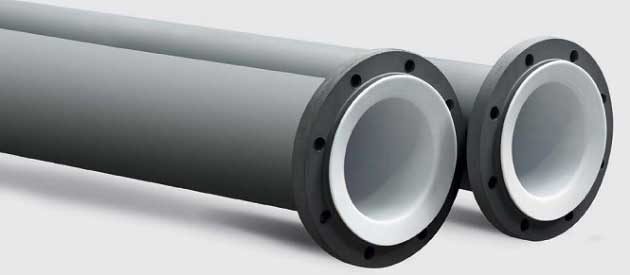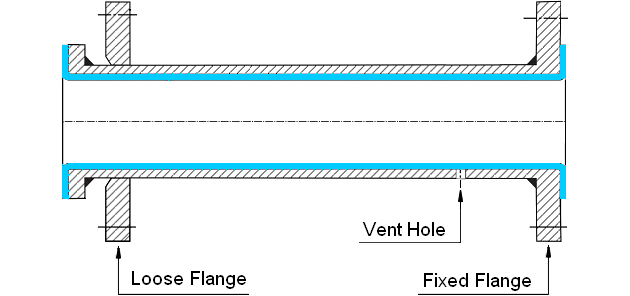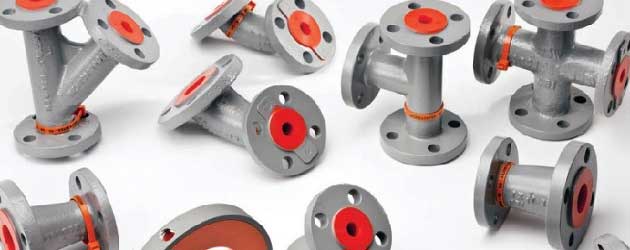 |
PTFE lined Pipes and Fittings |
In most of the Chemicals, Petrochemicals, Food industries, Pharmaceuticals, and almost every company handling highly corrosive and hazardous acids and solvents for their processing requirement the lined pipes systems find their application.
Often, these chemicals are to be conveyed from storage vessels to the mixing tanks or reactors where they form an intermediate product. Being highly acidic and corrosive in nature, these chemicals have a tendency to corrode and eat away the steel piping which are used as conveyors, leaving the system useless and unsafe for use.
To prevent corrosion e.g. in a pipe system, internal PTFE lining can be applied to steel pipes, elbows, tees, reducers, spacers, valves and other fittings installed in a pipeline.
Advanges of used lined pipe systems
- The life of pipeline systems increases due to absence of corrosion
- PTFE lining safeguards and enhances better working conditions as leakage does not occur and subsequent harmful gases and vapors do not evaporate in the atmosphere.
- The cost incurred in maintenance, repairing and time lost can be minimized.
- A wide variety of chemicals can be used through a PTFE loned system, making it more flexible and economical.
- Abrasion and wear resistant while maintaining nonstick and high purity characteristics.



PTFE in Chemical Service
PTFE (Polytetrafluoroethylene) fluorocarbon resins represent one of the most versatile products lines ever to emerge from Du Pont laboratories. From Exotic space-age applications to molded parts and wire and cable insulation to its consumer use as a coating for cookware, PTFE has fulfilled a wide variety of roles in its 40-year history.
One of its largest and fastest growing uses today is for corrosive protection. This use is attractive because PTFE resins are chemically inert to almost all industrial chemicals and solvents. This nearly universal chemical inertness stems from three characteristics of PTFE molecule: (1) the very strong interatomic bonds between carbon and fluorine atoms; (2) the almost perfect shielding of the polymers carbon backbone by fluorine atoms; and (3) the very high molecular weight (or long polymer chain length) compared to many other polymers.
There are three members of the family of PTFE resins:
PTFE TFE resin - the original PTFE resin invented by Du Pont in 1938. Normally it is an opaque, white material. When melted it does not flow like other thermo plastics and must be shaped initially by techniques similar to powder metallurgy. Maximum continuous service temperature is 260°C.
PTFE FEP resin was also invented by Du Pont and became a commercial product in 1960. It is a true thermoplastic that can be melt extruded and fabricated and is transparent in thin sections. It eventually becomes translucent as thickness increases. Maximum continuous service temperature is 205°C.
PTFE PFA resin - introduced in 1972, has excellent melt-processability and properties rivaling or exceeding those of TFE. PFA permits conventional thermoplastic molding and extrusion processing at high rates and also has higher mechanical strength at elevated temperatures. Maximum continuous use temperature is 260°C.
The use of PTFE in chemical processing equipment began in the late 1940’s. The early applications were gaskets and valve packing’s, valve diaphragms and mechanical seals. These led to the development of linings of pipes, valves, pumps and vessels, hence completely lined chemical processing systems. The liner developments were aided considerably by the advent of the melt-processable PTFE FEP resins and film. The new melt-processable PTFE PFA resin is proving to be valuable addition in broadening the many chemical uses of PTFE. Descriptions of typical applications for fabricated forms of these resins are appended. From these we see that the resistance of PTFE to both high temperatures and corrosive chemicals is providing solutions to many of the more difficult problems in chemical processing today.
Datasheet PTFE
| Properties | Method | Unit | Typical Values (from-to) |
| Specific gravity | ASTM D792 | - | 2,14 - 2,20 |
| Tensile strength | ASTM D1457 | MPa | 20 - 35 |
| Elongation at break | ASTM D1457 | % | 210 - 400 |
| Compressive strength 1% deformation | ASTM D695 | MPa | 4,00 - 4,50 |
| Deformation under load 14 N/mm2 for 24hrs | ASTM D621(1) | % | 44849 |
| Flexural strength 0,7 N/mm2 | ASTM D790 | MPa | no break |
| Module of elasticity in tension | ASTM D 790 | MPa | 700 |
| Impact strength (Izod) 57°C | ASTM D256 | KJ/m2 | 1,10 |
| Impact strength (Izod) 23°C | ASTM D256 | KJ/m2 | 1,60 |
| Impact strength (Izod) 77°C | ASTM D256 | KJ/m2 | 3,30 |
| Hardness | ASTM D2240 | (shoreD) | 50 - 60 |
| Friction coefficient - static | ASTM D3028 (2) | - | 0,09 |
| Friction coefficient - dynamic | ASTM D3028 (2) | - | 0,05 |
| PTFE - steel oil lubricated | - | - | 0,02 - 0,06 |
| Working temperature range | - | °C | -460 |
| Coefficient of thermal expansion from 25 to 100°C |
ASTM E831 | 10-5* C-1 | 16 |
| Thermal conductivity | ASTM D2214 | W/mK | 0,20 |
| Specific heat 0°C | - | J/g.K | 0,96 |
| Specific heat 50°C | - | J/g.K | 1,05 |
| Temperature of distortion 0,46 N/mm2 | ASTM D648 | °C | 130 - 140 |
| Temperature of distortion 1,85 N/mm2 | ASTM D648 | °C | 50 - 60 |
| Dielectric strength (short-time air thickness 0,5 mm) |
ASTM D149 | kV/mm | 55 |
| Dielectric constant | ASTM D150 | - | 2,10 |
| Dissipation factor | ASTM D150 | - | 0,0002 |
| Volume resistivity | ASTM D257 | Ohm/cm | 44851 |
| Surface resistivity (3) | ASTM D257 | Ohm | 44849 |
| Arc-resistance | ASTM D495 | sec | OK (4) |
| Water absorption | ASTM D570 | % | 0,01 |
| Flammability accodind to UL94 | VO |